Mortar ... raft!

Gunboat northerners "Tuler" and near the coast, two mortars.
With the beginning of the civil war between the North and the South, as you know, the military command of the northerners adopted the plan of "stranglehold." Its essence was to isolate the southern states with the help of the blockade from the entire civilized world and thereby make them capitulate. However, the plan had a rather serious flaw - the Mississippi River, which was in the hands of the southerners, and the states that were behind it in the West. From there, southerners could be supplied with food, and through Mexico to buy weapons.
Federal forces 13 inch mortars, battery No. 4, soldiers of the 1 Corps of Connecticut heavy artillery near Yorktown, Virginia, May 1862.
It was necessary to cut this major transportation artery, the “backbone of the rebellion,” as Lincoln said, but for this, firstly, it was necessary to introduce warships into Mississippi, and secondly, to take control of New Orleans. Well-armed forts prevented them from breaking through to the city. And there was simply nothing to act on the river, in connection with which the northerners in an expedited manner began, and then forced the construction of “brown-water battleships”, called Uncle Sam's fringed geese. Southerners also built similar ships. They were covered with armor from rails, casemates with inclined walls were installed on the decks of passenger Mississippi ships, armed with Parrot rifled guns and Dalgren’s smooth-bore guns and ... violent clashes of such improvised armadillos began to occur on the river here and there, so they even sold tickets . They set up shops on the shore and offered them to local residents along with grilled corn and drinks. However, it was not easy to break through to Orleans from the sea.
As you know, at that time they were even placed on railway platforms ...
It was decided to combine the actions of the army and fleet. The fleet provided a breakthrough, the army landed troops, numbering 18000 people. But how to suppress forts, because the fire of land guns is always more accurate than those that are afloat ?! However, the military decided that no forts (and the experience of Sevastopol had already proven by this time!) Could withstand the fire of heavy mortars, such as the 330-mm dictator mortar weighing 7,7 tons, firing a 200-pound bomb. Place this killer weapon was decided on sailing schooners. It seemed to be obvious that a massive shelling of forts with mounted fire would destroy their fortifications, inflict huge losses on the garrisons, after which they could be captured even by very limited forces.
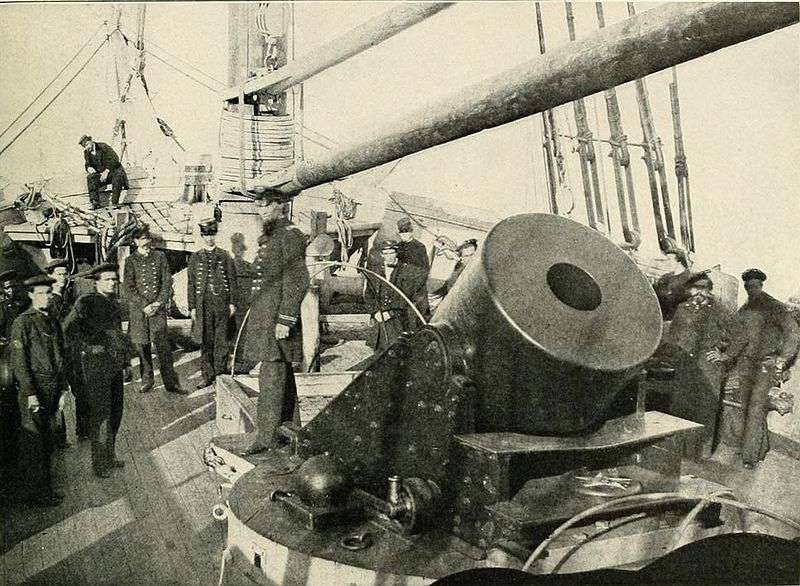
And this is the 330-mm mortar on the deck of the mortar schooner during the battles of New Orleans.
Admiral David Farragut, who commanded this operation, strongly doubted that the bombardment of these mortars would destroy the forts, and that such improvised boats would be generally useful. Instead, he proposed a rapid breakthrough past the forts under the cover of night darkness. Well, and having appeared above on the river, the fleet could land a landing, cut off them from bases of supply and force to capitulate without a uniform shot.
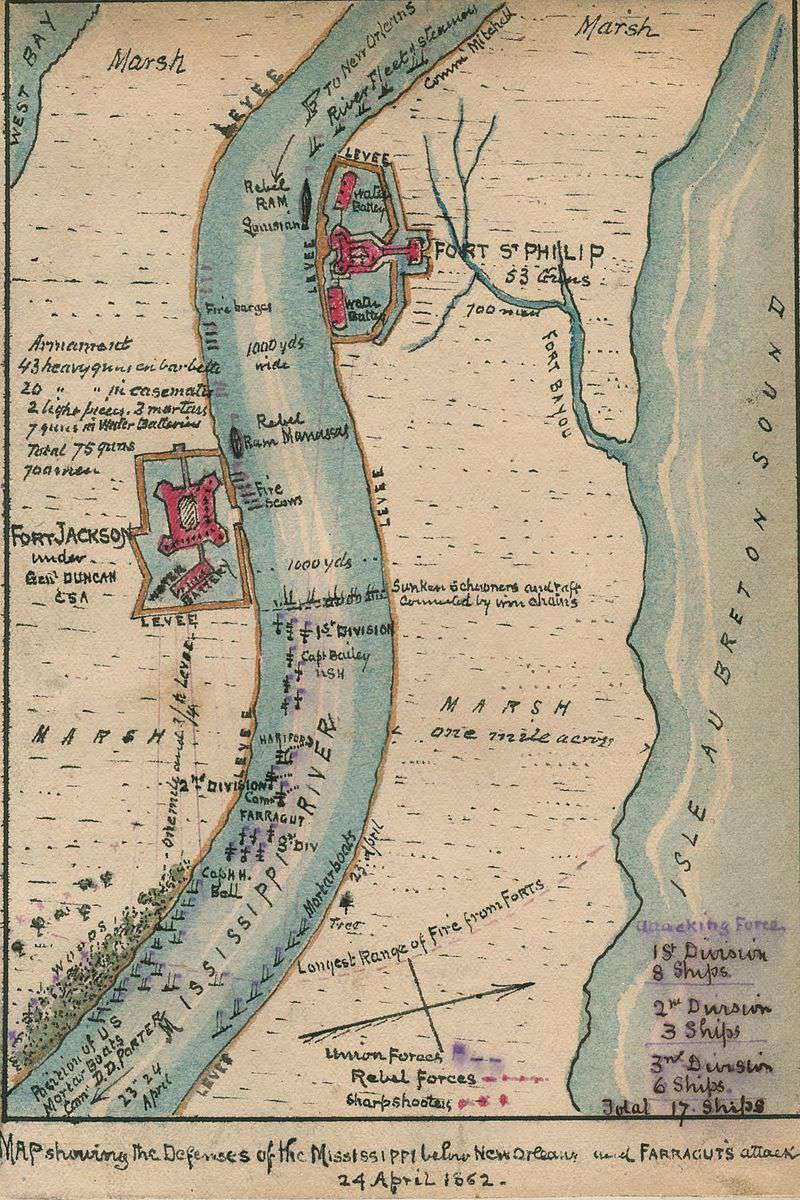
Watercolor map of Fort Jackson and Fort St. Philip.
But as Commodore David Porter, who had great political influence, and his stepbrother, who came to Farragut, commanded the mortar squadron, the admiral decided to agree to participate in this operation of mortar boats and bombard the forts instead of an unexpected breakthrough.
Another map, clearly showing the location of mortar ships, hidden behind the forest.
Position in front of the forts took in close proximity to them, but downstream. By 18 April 1862, the 21 mortar boat was anchored so that the terrain and forest on the shore sheltered them from return fire from the forts. In this case, the masts were removed from the boats, while they themselves were disguised with branches and freshly cut bushes.
Engraving 1903 of the year. The battle of the flagship of Farragut "Hartford" with the battleships of the southerners during the breakthrough to New Orleans.
Early in the morning of April 18, the mortar boats opened fire on the forts of their 330-millimeter mortars. The main goal was Fort Jackson, who was closer to the squadron. According to Porter, each mortar had to make one shot every ten minutes. However, they were unable to maintain this pace for a long time, although they fired more 1400 bombs only during the first day of the bombing. Porter decided that a continuous 48-hour bombardment would be enough to turn the fortifications into ruins, but the bombing had to be fought for a whole week, and the Northerners during that time fired more 7500 bombs.
The reason for such a long fire was banal: the fire was ineffective. Thus, of the hundred and twenty guns that were in the forts, only seven of them bombed out. The losses in the garrisons of the forts were simply depressing: two dead and several wounded. That is, they almost completely retained their combat capability, and it was not possible to take them without large losses. However, the reasons for such an unsuccessful shooting were purely technical: the fuses of the mortar bombs worked poorly. For example, in the early days, many bombs exploded in the air. Of course, this had a moral effect, but the garrisons were in dungeons and did not suffer losses. Upon learning of this, Porter gave the order to install the firing pipes with a maximum delay. But at the same time, the falling bombs simply began to bury themselves in moist soil, so that their explosions did not cause any special harm. So the mortar schooners of the hopes placed on themselves, on the one hand, did not justify. But on the other hand ... the bombs that were continuously falling and exploding on the forts turned the life of the garrisons there into hell. All the barracks were burned, the warehouses and water tanks were destroyed, and it was simply dangerous to walk around the forts in the dark in order not to fall into some kind of camouflage. For days and a half, the soldiers sat in stone dungeons in the heat and dampness, as they were partially flooded by the Mississippi spill. All this led to the breakdown of forces, both physical and moral. Soldiers, to put it bluntly, apathy seized. It is interesting that moral suffering directly proportional to the accuracy of the forts, which Farragut himself later noted. Fort Jackson afterwards, when his fleet nevertheless made a breakthrough, conducted much less accurate and not so intensive shooting than the fort Saint-Philip, following him, who suffered from mortar fire to a lesser extent.
Mortar ships bombard Fort Jackson.
As a result, it was nevertheless necessary to go on a breakthrough, but after the capitulation of the forts, it was decided that the mortar boats in their capture did render some assistance.
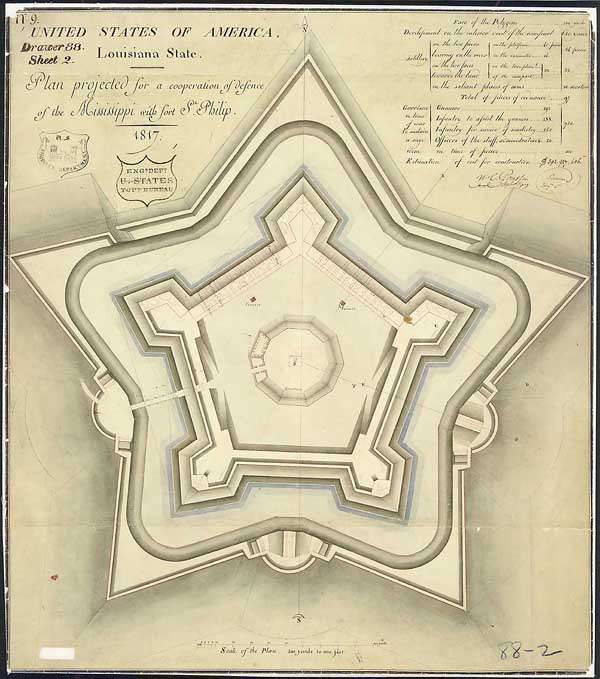
Plan of Fort St. Philip.
And here is a very specific person - flag officer Andrew Foot decided to try to go even further, namely, to install such mortars not on boats, but on special rafts! The fact is that mortars with a caliber of 330-mm had such a weight and such a strong return that the decks on the small schooners had to be seriously supported.
By this time, there had already been proposals to use rafts for transporting guns and troops, and even for ... reconnaissance, and this was even tried, and quite successfully. But here the offer was very much unusual. From the thick logs sheathed on top with planks, the hull of the raft, on which from the planks sheathed with iron sheets, a casemate with inclined walls in the shape of a hexagon was assembled. It was necessary to protect the crew of the raft from possible shelling from the shore and shell fragments.
The original design of a raft of rubberized teams caissons for transporting soldiers and guns, used during the civil war in the United States.
The 330-mm mortar was located inside the casemate with a supply of shells, and all — the mortar raft did not have any engine or space. But he, like every vessel, had anchors and towing cables. The benefit was very big. One wheeled steamer used as a tug could pull more than one such raft, but several at once. Then they were installed near the shore, if necessary, camouflaged and opened fire. In this case, the crew of the raft before the shot often left its dungeon and was outside. Well, it was almost impossible to hit such rafts, as they stood near the shore, and besides they were hiding around the bends of the river. Such rafts were used in the bombardment of the island number XXUMX and Fort Pillow. It should be noted that one very interesting one is also connected with Fort Pillow. story during the civil war in the United States, and perhaps this historical event will also be discussed here someday.
Well, in conclusion, it should be noted that the source for this material was James M. McPirson’s book War on the Water, published in the USA in 2012 by the University of North Carolina publishing house: James M. McPherson. War on the waters. ISBN 0807835889. In particular, there on page 80 a remarkable engraving of that time is placed, depicting a shot from one such mortar raft ...
Painting by Moritz de Haas. Farragut's fleet breaks through the forts Jackson and St. Philip to New Orleans.
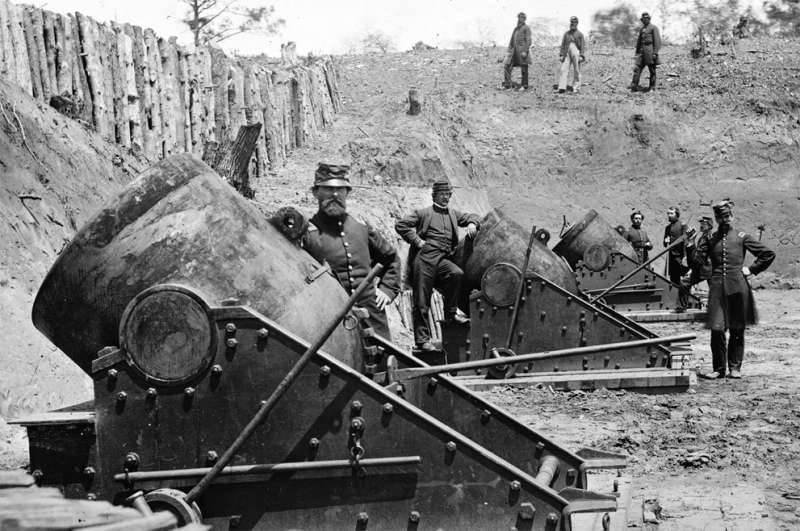
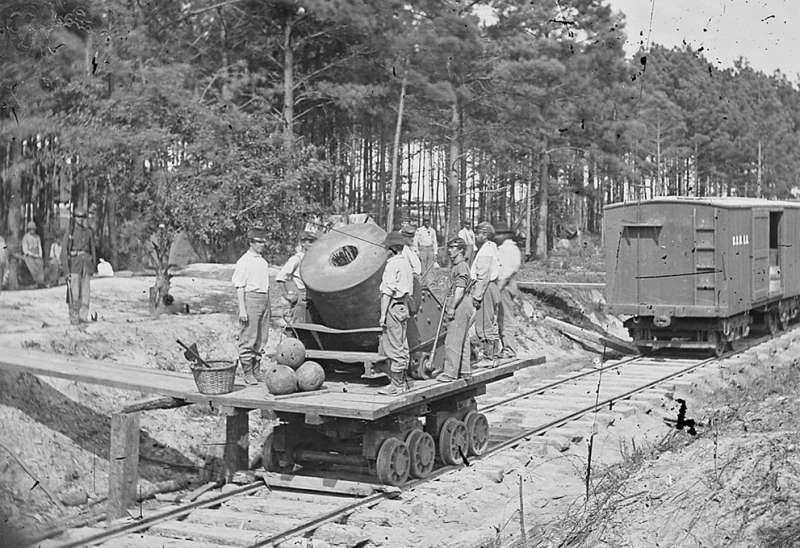
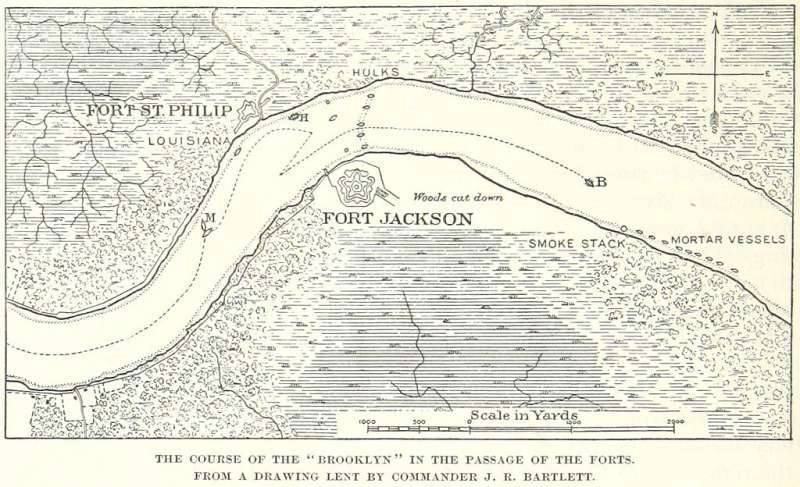
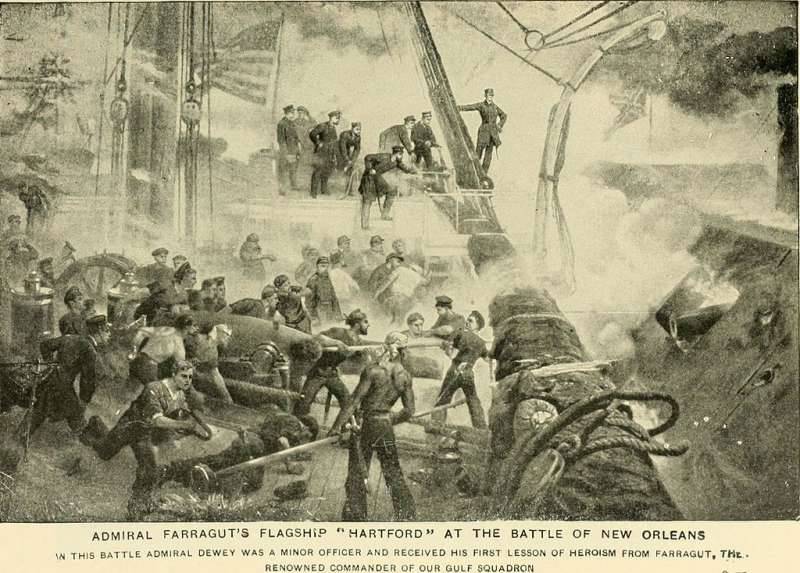
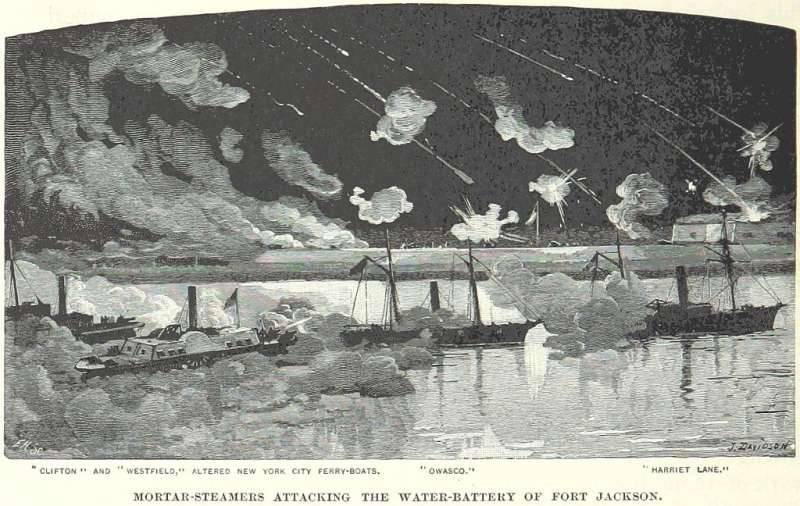
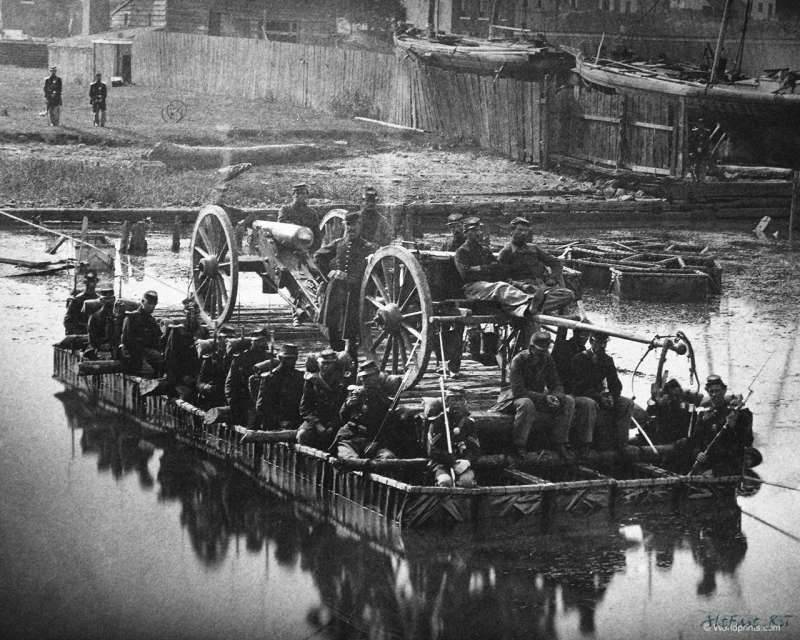
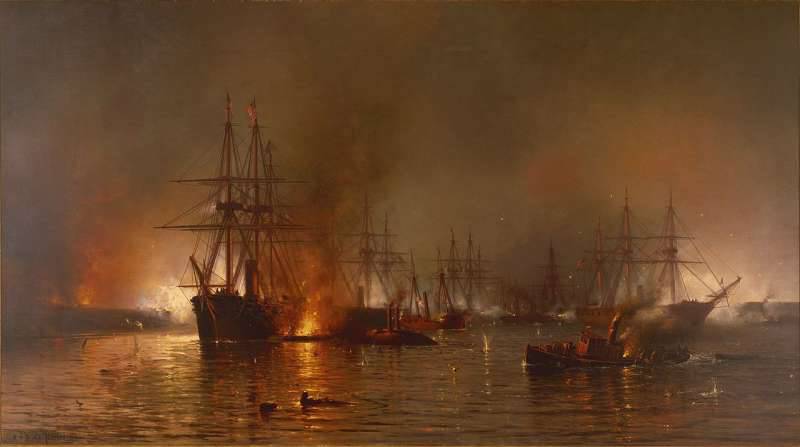
Information